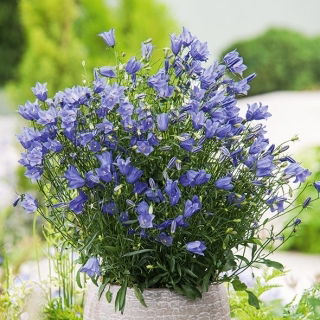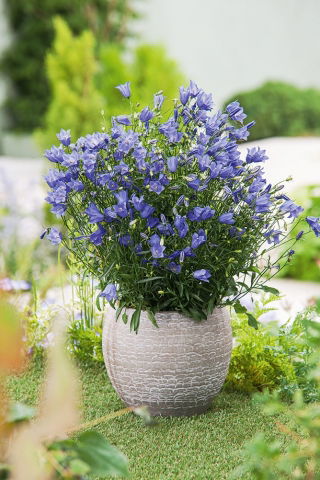The Harebell, known for the charm of its violet-blue flowers, is an excellent choice for lovers of rock gardens and flower beds. This perennial plant, reaching a height of around 30 cm, stands out not only for its aesthetics but also for its ease of cultivation. With its branched, underground rhizomes, it forms low, loose clumps that blend beautifully along the edges of lawns, paths, and flower borders. The high-quality Harebell seeds available at Garden Seeds Market are the result of meticulous laboratory research, ensuring their reliability and safety. Satisfied customer reviews and quick delivery are additional benefits that make this product a great choice.
Sowing
The Harebell is best sown in a well-sunlit location, which promotes its lush growth. The seeds of this plant can be sown both under cover and directly into the ground, providing greater flexibility in garden planning. It thrives on various soil types, making it a versatile choice for any garden.
Sowing Depth
Harebell seeds should be sown at a depth of about 0.3 cm. This depth provides optimal germination conditions, leading to healthy plant growth. It is recommended to lightly cover the seeds with a layer of soil to provide them with suitable growing conditions.
Direct Sowing Period
When should you sow Harebell seeds directly into the ground? The best period for sowing is spring when the soil temperature is sufficiently high. Sowing at this time allows the plant to get a quick start and prepare for an intense growth period.
Sowing Period Under Cover
When should you sow Harebell seeds under cover? The optimal time to start sowing is spring, allowing for earlier germination and development of young plants. Sowing under cover protects the seeds from spring frosts, providing them with safe conditions for growth.
Planting Time
The best time to plant Harebells is in summer when the plants are well-rooted and ready to be transplanted to their permanent spot in the garden. Seedlings should be placed in pre-prepared holes, enabling their further development and flowering.
Plant Spacing
Plants should be spaced 15x30 cm apart, allowing them to develop freely and create aesthetically pleasing clumps. Proper spacing is crucial for ensuring the plants have access to light and nutrients.
Companion Planting
The Harebell pairs excellently with other ornamental plants, such as carnations, daisies, and irises. Creating compositions with these plants can yield striking arrangements that attract attention with their colour and form.
Site Conditions
The Harebell prefers sunny or lightly shaded locations. The soil should be well-drained and of moderate moisture. This plant grows well in sandy or clay soils enriched with compost or other natural fertilisers. Regular watering, especially during dry periods, is key to healthy growth and abundant flowering.
Growing Tips
The Harebell is easy to cultivate, making it an attractive choice for both novice and experienced gardeners. Regular removal of faded flowers promotes longer blooming. The plant should be fertilised every few weeks to provide it with the necessary nutrients.
Plant Height
The Harebell reaches a height of approximately 30 cm, making it an ideal element in border and rock garden compositions. Its compact growth makes it perfect as an edging plant.
Flowering Period
The Harebell blooms from June to September, making it a constant garden ornament throughout the summer. Abundant flowering can be achieved through regular care and removal of faded flowers.
Usage
The Harebell is perfect as an ornamental plant in rock gardens, flower beds, and compositions along the edges of paths and lawns. Thanks to its beauty and low maintenance requirements, it is often chosen for creating naturalistic arrangements. This plant can also be planted in pots and containers, allowing its use on terraces and balconies.
Resistance to Diseases
The Harebell is resistant to most diseases, making it easy to grow. Regular watering and proper site conditions are key to healthy growth. However, it is worth monitoring the plants for potential pests to respond quickly if needed.
Good to Know
The Harebell not only pleases the eye but also attracts bees and butterflies, making the garden more eco-friendly. Its bell-shaped flowers are not only beautiful but also durable, making them ideal for creating summer bouquets. Cultivating this plant does not require specialised knowledge, making it an ideal choice for any gardening enthusiast.
Why Buy from Garden Seeds Market
Garden Seeds Market guarantees high-quality seeds that undergo meticulous quality testing. With a wide assortment and competitive prices, everyone can find something to suit their needs. Fast and secure delivery and excellent customer service are additional advantages that encourage shopping here. Satisfied customer reviews confirm that shopping at Garden Seeds Market is a wise choice for any gardener.
The package contains 0.1 g of seeds. The packaging includes information on cultivation guidelines and the sowing expiry date.






